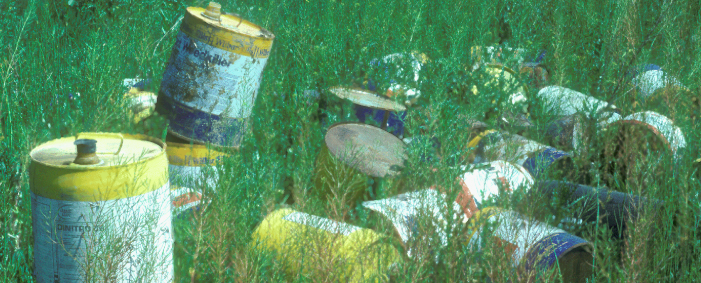
Pesticide wastes consist of all or a portion of pesticides and materials contaminated with pesticides. This definition includes rinsing water (from rinsing empty containers and sprays), expired or withdrawn concentrate, empty containers, remaining slurry, spill residue and contaminated soil.
There are two types of waste; household waste generated by the personal use of Class 4 and Class 5 pesticides, and commercial waste generated by the use of Class 1, 2 and 3 pesticides. All of this waste may, on some occasions, become hazardous under the Hazardous Materials Regulations.
Domestic waste (empty containers and well-wrapped small spill containment materials) can be disposed of through household waste if it is not a hazardous material. Domestic expired products are recovered via household hazardous waste collections organized by municipalities. Agricultural, commercial and industrial waste must be disposed of according to the following obligations and advice.
Empty containers
All empty containers should be carefully drained and rinsed, using triple rinsing or pressure rinsing. Rinsed containers are then rendered unusable by crushing or puncturing them (except those taken by the manufacturer) to ensure that they will not be used for other purposes. Empty containers, kept in a safe place until final disposal, must not be burned or buried under any circumstances.
AgriRÉCUP organizes an annual agricultural empty container recovery program. Empty, clean containers (rinsed three times) with their corks and tags removed are accepted at participating retailer sites.
Many companies offer high-volume, returnable and reusable containers. Containers are filled and sealed at the factory; after use, the rinsed containers are returned to the companies’ depot. The use of water-soluble bags or containers may also limit the proliferation of empty containers in the environment.
Remaining porridge
In order to avoid excess slurry, it is important to evaluate as accurately as possible the quantities of slurry to be spread according to the extent to be treated and the recommended dose. The excess slurry can be stored for later application or used on an area that has not yet been treated but requires the same treatment. These residues should not be dumped on vacant lots or unused land so as not to unnecessarily damage any other ecosystem. Similarly, they should not be thrown into the sanitary or storm sewer, or into equipment that spills into it. Facilitated tanks are recommended to reduce excess spray volume.
Rinsing waters
Rinsing water produced by cleaning containers (empty containers, sprays, etc.) causes a significant amount of liquids containing low concentrations of pesticides. These rinsings must be spread over the area already treated when this operation does not affect the effectiveness of the treatment. If this type of disposal is unsuitable, rinse water should be sprayed in a low risk area away from streams, lakes and wells (50 meters). Again, it is forbidden to throw the rinsing water into the storm or sanitary sewer or into equipment that flows into it.
Pesticide injection systems installed on sprayers that mix the concentrated pesticide and water immediately before passing through the nozzles are recommended. Water soluble bags that limit rinse water and returnable containers are also recommended.
Surplus concentrates and expired products
Surplus concentrates and expired products contain concentrated active ingredients. These products are generally toxic and must be stored in a safe place.
Unwanted containers of unused products may be kept for later use or returned to suppliers, if accepted. In addition, every three years, UNMARFA implements a program for the safe collection and disposal of registered, obsolete or unusable agricultural pesticides.
As a last resort, unusable (obsolete or out of use) pesticides, which are not domestic products, must be disposed of properly. As they often have the properties of a hazardous material under the Hazardous Materials Regulations, they must be recycled or disposed of by Ministry of the Environment permit holders. Their addresses are available at the Department’s regional offices. To eliminate these pesticides, it is necessary either to burn them (organic ingredients) in hazardous waste incinerators or to stabilize them (inorganic ingredients). Where products are to be stored for a period of time prior to their disposal, the Hazardous Materials Regulations storage standards apply only when the products are recognized as hazardous materials and the amount of concentrated pesticides is greater than 100 kilograms.
Spill residues and contaminated soils
In the event of a spill, it is necessary to notify Urgence-Environnement Québec. In the meantime, it is essential to confine the liquids by constructing a backfill around the contaminated site, with absorbents. In all cases, even if it is a minor spill, the absorbents used to collect the residues (sand, sawdust, vermiculite, etc.) are considered as pesticide waste. Thus, they must, just like pesticide-contaminated material with the properties of a hazardous material, be managed as hazardous materials unless testing shows that the residue is contaminated below the standards allowed by the regulation.
During a spill on the ground (other than a large spill that will be decontaminated), contaminated and excavated soil is also considered pesticide waste. All containers containing soil or absorbent materials impregnated with pesticides must be sealed, marked and stored in a secure location until disposed of by a specialized company holding the permit from the Department. Never use water to dilute spilled pesticides.
In the case of soil contamination resulting from the deficient storage of pesticides, a pesticide warehouse fire, or a major spill or the detection of a major contamination, land reclamation is planned. According to the Soil Protection and Contaminated Sites Rehabilitation Policy the landowner must register the presence and nature of the soil contamination with the Land Registry Office. Lands that pose a significant risk to human health, wildlife and flora must be subject, as appropriate, to decontamination, containment or restrictive use measures. Excavated soils and sediments must be managed so that they do not constitute a new source of environmental contamination. Thus, excavation, transportation and soil treatment must be done in a manner that prevents or minimizes the dilution and transfer of contaminants to another environment.